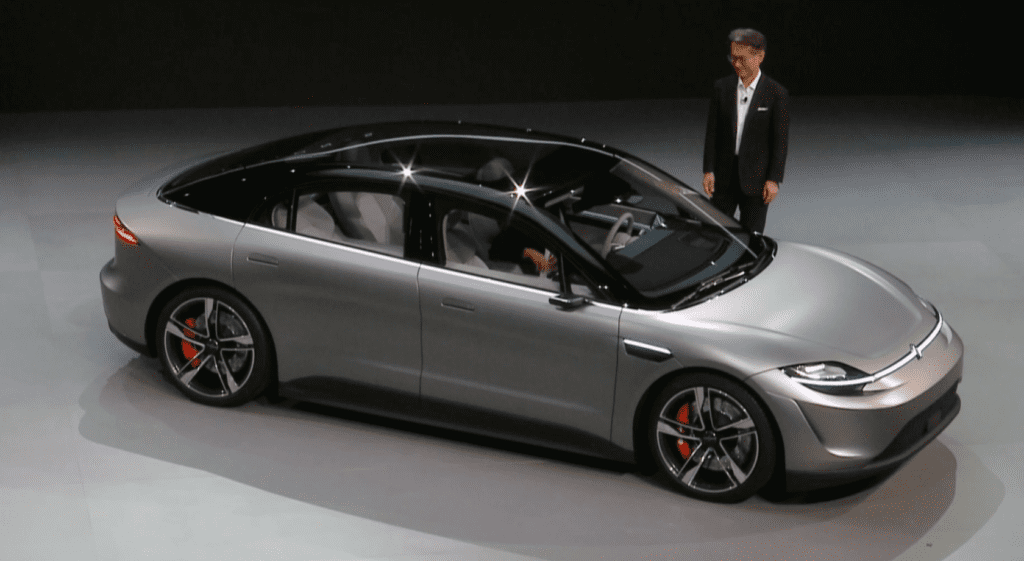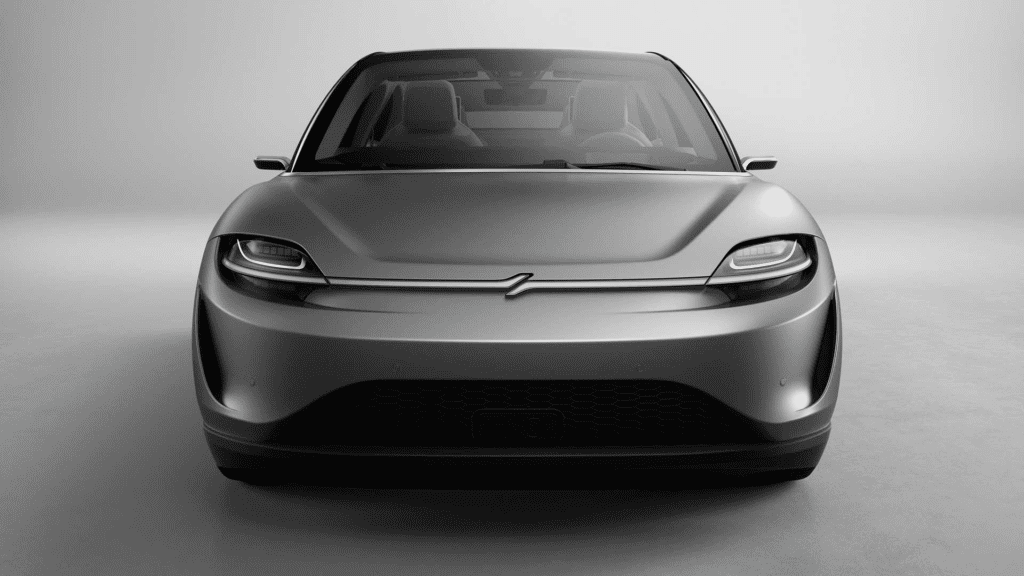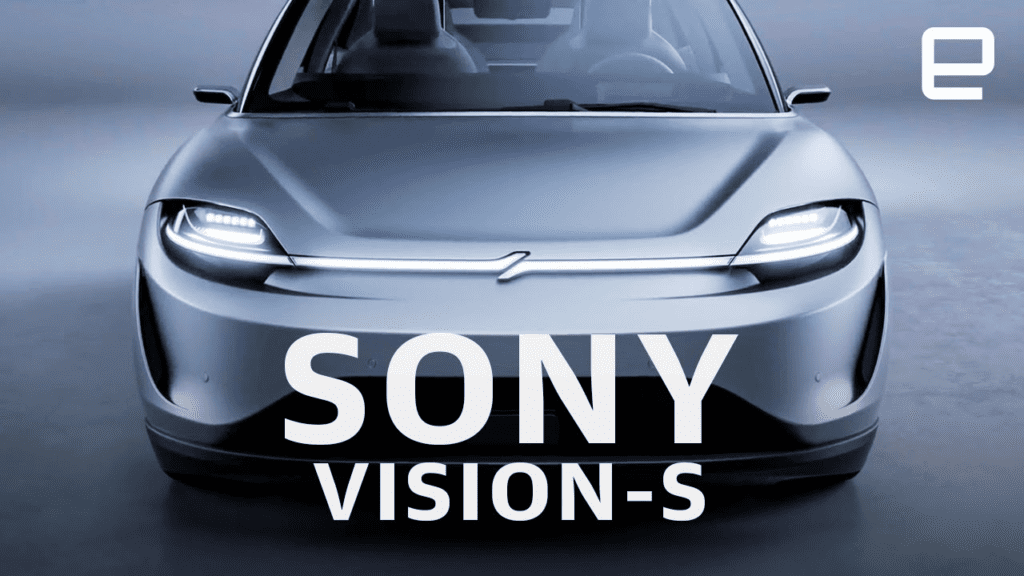In January of this year, Sony Honda Mobility exhibited the latest prototype of the smart EV “AFEELA” currently under development at the electronics show “CES 2024.” We asked Daisuke Ishii and Taku Kono, who lead Sony Honda Mobility’s design and brand strategy team, to talk about the evolution of AFEELA, which is approaching completion step by step, from the perspectives of product design and user experience.
Building a co-creative environment between Sony Honda
After Sony Honda Mobility was established in 2022, AFEELA’s design and brand strategy team overcame the differences in work styles and ways of thinking between the two companies to create a single co-creation environment.
The team led by Mr. Ishii and Mr. Kono will be responsible for not only AFEELA’s product design, but also the various user experiences (UX) created by mobility-related services, as well as the brand strategy that supports the company’s identity. A designer from the Design & Brand Strategy Department was in charge of the concept for the company’s head office in Tokyo. The entrance, which reflects the same minimalist concept as AFEELA, is a symbolic location, and the designer collaborated with an external design firm to create the spatial design.
AFEELA is a smart EV that has been designed not only for its body, but also for the driver and all passengers, from the time they get into the car to the “feelings and experiences” they experience after getting out of the car.
In order to connect the two different corporate cultures of Sony and Honda, the first task the design and brand strategy team took on was to define the purpose of Sony Honda Mobility. The designers themselves interviewed various employees and had repeated discussions with top management based on the extracted keywords. As a result, the purpose of “pursuing innovation with diverse knowledge and motivating people” was born.
The name AFEELA symbolizes Sony Honda Mobility’s core technology. The product development concept is also defined by the three A’s: Autonomy (evolving autonomy), Augmentation (expansion of the body and space and time), and Affinity (cooperation with people and coexistence with society). There is. The word “FEEL” is sandwiched between the “two A’s” of “Autonomy” and “Augmentation,” and the “other A,” “Affinity,” has the meaning of affinity, trust, and intimacy. It expresses an emotional connection.
Famous machine design passed down from generation to generation
AFEELA’s new prototype reflects both “Sony-ness” and “Honda-ness.” Mr. Ishii says that the focus was on eliminating unnecessary elements and maximizing the user experience.

“Sony Design and Honda Design supported the dawn of Japanese product design. Among them, the portable audio player “Walkman” and Honda’s third generation “Wonder Civic” became good models. AFEELA’s design follows in many ways from Honda’s MM concept (Man Maximum/ Mechanical Minimum ), which maximizes the space available to customers.” (Mr. Ishii) )”, Honda has a robot called “asimo”. The knowledge gained from each product design was also utilized in AFEELA. The common essence is that they are “consisted of minimal, streamlined lines and soft, round surfaces throughout.”
Furthermore, AFEELA combines a sharp shape with the chassis platform of the suspension. Mr. Kono explains the reason. “If the design of a large product like a car is too simple, it may look boring or lack a sense of solidity. AFEELA incorporates the design elements of robotics, while creating a simple and fulfilling form. “(Mr. Kono) The 2024 prototype has a more geometric shape than the first prototype announced in 2023, and everything from the composition of the parts to the necessary split lines has been refined. Thoroughly reviewed. Mr. Ishii says that he was conscious of the appeal of “mobility = a moving object” and brought out that even more strongly.
The latest prototype has completely redesigned the surfaces that flow from the front, sides, rear, and wheel arches. The front and rear bumper structures have been revised, and the front air intake and rear reflector have been integrated with a black garnish to enhance functionality and aesthetics at the same time. The previous generation prototype had a horizontal design that emphasized the horizontal appearance. In the 2024 prototype, a wedge-shaped element was added to the cutting shape, adding an accent to the intonation of the body and highlighting its beauty as a “driving product.”
Mr. Kono recalls that he took pains to emphasize the design of “4 legs = 4 wheels” and to “adjust the adjustment” to increase the stability of the car body. “While it is not difficult to clearly emphasize the impression of the legs, AFEELA places even greater emphasis on the overall balance.High quality and reliability are clearly visible through the simple design that eliminates waste. I think our challenge is to create a design.” (Mr. Kono)
Advanced technology that makes your design stand out
Cutting-edge technology related to mobility also makes AFEELA’s user experience unique.

There are numerous sensors and cameras inside and outside the vehicle. AFEELA supports safe driving based on highly accurate information obtained by monitoring the surrounding area 360 degrees while driving. Inside the car, a large panoramic screen spreads out on the front panel, displaying driving information and entertainment content. In particular, the steering wheel has a yoke design with the upper half open to improve visibility of driving information.
AFEELA has no door handles on its body surface. A sensor detects when a driver approaches, and a facial recognition camera unlocks the vehicle. After exiting the vehicle, the doors are automatically locked. Mr. Ishii suggests that by applying facial recognition, it is possible to securely provide a variety of functions optimized for users. A new special paint was also used to paint the car body so as not to reduce the sensing accuracy of the radar that supports safe driving.
We asked Mr. Kono about the characteristics of the material. “Normally, when metallic paint is used, it becomes difficult for radar radio waves to pass through due to diffuse reflection.The new paint used for the 2024 prototype ensures radar transmittance while creating a unique and attractive color that is neither solid nor metallic. We call this slightly bluish, deep color ‘Tidal Gray.’It changes its appearance into various colors when it catches the light.” (Mr. Kono)
Users can freely personalize AFEELA
With AFEELA, users can enjoy personalization (customization) of some vehicle body design elements and various functions. There is no AFEELA emblem on the car body, but instead a digital emblem is displayed on the front display called “Media Bar.”

Mr. Ishii says that Media Bar is “also a medium that connects mobility and communication with users.” When AFEELA detects the driver or passenger, it reacts by displaying various information on the Media Bar. For example, it is expected to be used for functional purposes such as displaying the remaining battery level and the time it will take to fully charge the battery.
AFEELA’s design elements extend to e-motor sounds that function as a simulated engine sound while driving and as an AVAS (Acoustic Vehicle Alerting System). At Honda, the sound design is determined by the regulations related to safe driving of cars, and at Sony Honda Mobility, a full-time sound designer handles the design. “Through the development of AFEELA, the possibilities for expression related to sound have expanded,” says Kono.
So, what kind of e-motor sounds will be available in AFEELA? Mr. Kono answered, “While following safety standards that vary by country and region, we would like to pursue sound creation that is unique to AFEELA, including whether e-motor sound should be a so-called “car-like sound”.”
Sony Honda Mobility has opened a part of AFEELA’s development environment and launched a program to “co-create” content displayed on the Media Bar and panoramic screen, as well as e-motor sounds, with external developers. AFEELA is likely to be a unique smart EV that users can drive like a digital gadget.
Pursuing user-friendly operability
As a new development for AFEELA related to AI, it was also revealed at CES that Sony Honda Mobility will independently develop an interactive personal agent that utilizes “Microsoft Azure OpenAI Service.” How do Mr. Ishii and Mr. Kono envision the future of user experience through personal agents from their perspectives as designers?
Mr. Kono said, “The relationship between a human and an AI personal agent can take many different forms, such as a butler or a lover,” but he also said that the more the user continues to ride, the more deeply the personal agent understands the user. Ta.

Mr. Ishii stated that while advocating “the ideal form of a personal agent that is linked to safety and security,” Sony could also consider providing experiences such as safe driving support based on Sony’s specialty sensing technology.
Mr. Kono said, “In the past, it was thought that there was value in allowing the user to master the various quirks of a car, such as taming a wild horse or controlling horsepower. AFEELA brings the feeling of familiarity from the car to the user. I want to cherish it,” he says. If the operability of AFEELA, which is packed with cutting-edge technology, became complicated and strange, it would be useless. From an accessibility perspective, Mr. Ishii and Mr. Kono agree that they want to make AFEELA a user-friendly form of mobility.
For example, the user interface displayed on the panoramic screen allows selection operations not only by touching the screen, but also by using the hard keys on the steering wheel and the jog dial on the center console. Depending on the content of the operation, using a hardware controller may be more intuitive than using a screen touch, as it provides an analog operation that is closer to the user’s sensations.
On the other hand, like automatic doors that open and close by holding up a smartphone equipped with facial recognition and NFC functions, AFEELA can improve the satisfaction of owners who are not familiar with digital gadgets, including reducing the burden by minimizing physical operations. Pursue from various perspectives.
I wonder when AFEELA’s design will switch from a prototype to a mass production type in preparation for the start of pre-orders scheduled for 2025. In this interview, we got a glimpse that development is progressing smoothly, but Mr. Ishii also said, “I am aware that everyone’s interest and expectations are high.We are looking forward to future development that will exceed everyone’s expectations.” I want to deliver it to you.”
Mr. Kono was relieved that the 2024 prototype was released, saying, “We’ve finally made it to the starting line.” Mr. Kono, who wants to continue to greedily pursue the possibilities of mobility, says, “Since this product is selling well now, AFEELA has no intention of adopting a strategy of following suit. Whatever we create in the future, I want to convey the uniqueness of AFEELA,” he concluded.
